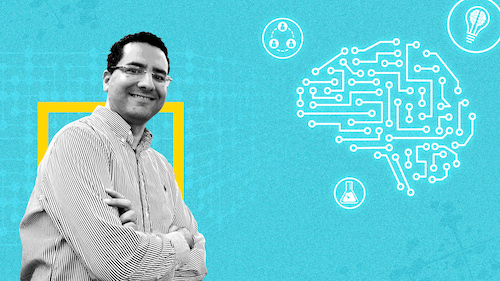
Faculty, staff and students have had to reinvest a lot of their energy over the past nine months coping with a global pandemic. And rightly so. But it’s important to note that the redistribution of effort hasn’t completely halted progress on other important work at the university. UM-Dearborn’s new artificial intelligence center is a great case in point. The Dearborn Artificial Intelligence Research (DAIR) Center was founded less than a year ago. But organizers have already made some important progress toward their goal of making AI one of the university’s topline areas for research, education and industry collaboration.
The DAIR Center’s Founding Director and Associate Professor of Computer and Information Science Marouane Kessentini says one of the main reasons for creating the center was to ignite more collaboration among the many faculty and students whose work involves AI. He says that’s imperative because today’s most interesting and relevant AI problems are often so complex, no one researcher can tackle them alone. “The deep projects require people from computer science, people who have core expertise in statistics and business, and even people who have an understanding of ethics and human behavior,” Kessentini says. “So the goal is to bring us all together to enable much larger-scale research than we’ve done before and which is required by today’s industry.”
Over the past year, the DAIR Center has organized a constant stream of activities to nurture that culture. One of the most productive, he says, has been weekly brainstorming sessions, which are often centered on broad funding opportunities rather than specific AI research areas that might attract some folks and not others. Through those sessions, DAIR Center teams have already brainstormed, vetted and submitted numerous proposals, including a smart cities-focused project designed to support the Urban Futures component of UM-Dearborn’s new strategic plan. The approach seems to be working, too: Several of the DAIR Center team projects have already won funding. And the center also recently organized a joint training with IBM on AI for smart manufacturing that attracted more than 150 participants from industry and academia.
Kessentini says this same philosophy could also reshape the student experience of AI, with a more interdisciplinary curriculum and increased opportunities to work closely with business leaders. In their conversations with industry, one of the themes they heard again and again was a huge need for talent that transcends mere technical expertise. “When we talk about building real-world AI systems, it goes far beyond just knowing algorithms and the basics of computer science. They’re looking for people who can actually understand the ethics part of AI, the biases in the data, and build systems that account for all of that.” To that end, Kessentini says UM-Dearborn and the DAIR Center hope they’ll soon be launching an interdisciplinary master’s degree in artificial intelligence — the first program of its kind in Michigan.
The mantra for building the new center is “think big, start small, and scale fast,” and even less than a year in, it looks like they’re starting to eye that third step. Already, the DAIR Center’s ranks include more than 40 faculty from CECS, COB and CASL, 30 doctoral students, and dozens of alumni and industry partners, including big names like IBM, eBay and Sumitomo. They’re hopeful they’ll attract even more interest through a big AI symposium later this month. That will feature five days of keynotes and panels, and top execs from Google, IBM, Ford, Oracle, GM, Intel and more.
There will also be multiple activities where students and faculty can lay the ground for future collaborations. For example, to simulate the quintessential meet-and-greet in-person mixer, they’re trying out something called “mystery speed networking.” “Basically, the platform will select two random people and connect them together for two minutes,” Kessentini says. “So you have time to introduce yourself, and then you can push a button to exchange business cards. At the end of two minutes, you get connected to another person.” Because the process is completely random, he says it’s totally possible UM-Dearborn students could end up scoring some facetime with a VP at eBay, the head of analytics at Google, or the chief data officer at IBM.
If you’d like a chance at that yourself, registration for the DAIR Center’s Nov. 30-Dec. 4 AI Symposium is now open. You can view the full schedule and RSVP for free.
###
The DAIR Center is supported, in part, by financial gifts from eBay, IBM and Sumitomo. Want to learn more about the DAIR Center? Check out their website.





